Human Resources: Values and Contribution to Organisation Success
VerifiedAdded on 2022/11/24
|13
|3866
|186
Report
AI Summary
This report delves into the crucial role of Human Resources (HR) in fostering organizational success, using Sainsbury as a case study. It begins by exploring the significance of organizational design theory, its structure, and its application in achieving company objectives, emphasizing competitive advantage, innovation, and efficiency. The report then examines techniques for attracting, developing, and rewarding human resources, highlighting the importance of a positive work environment, recognition, and employee engagement to create a skilled workforce. Furthermore, it investigates emerging HR developments and their impact on work procedures, including data-driven decision-making, employee well-being, and remote work strategies. The report also explores the relationship between organizational design and change management, analyzing how organizations must adapt to evolving environments. Finally, it provides a comprehensive overview of the McKinsey 7S Model and its application to assess and improve organizational design.
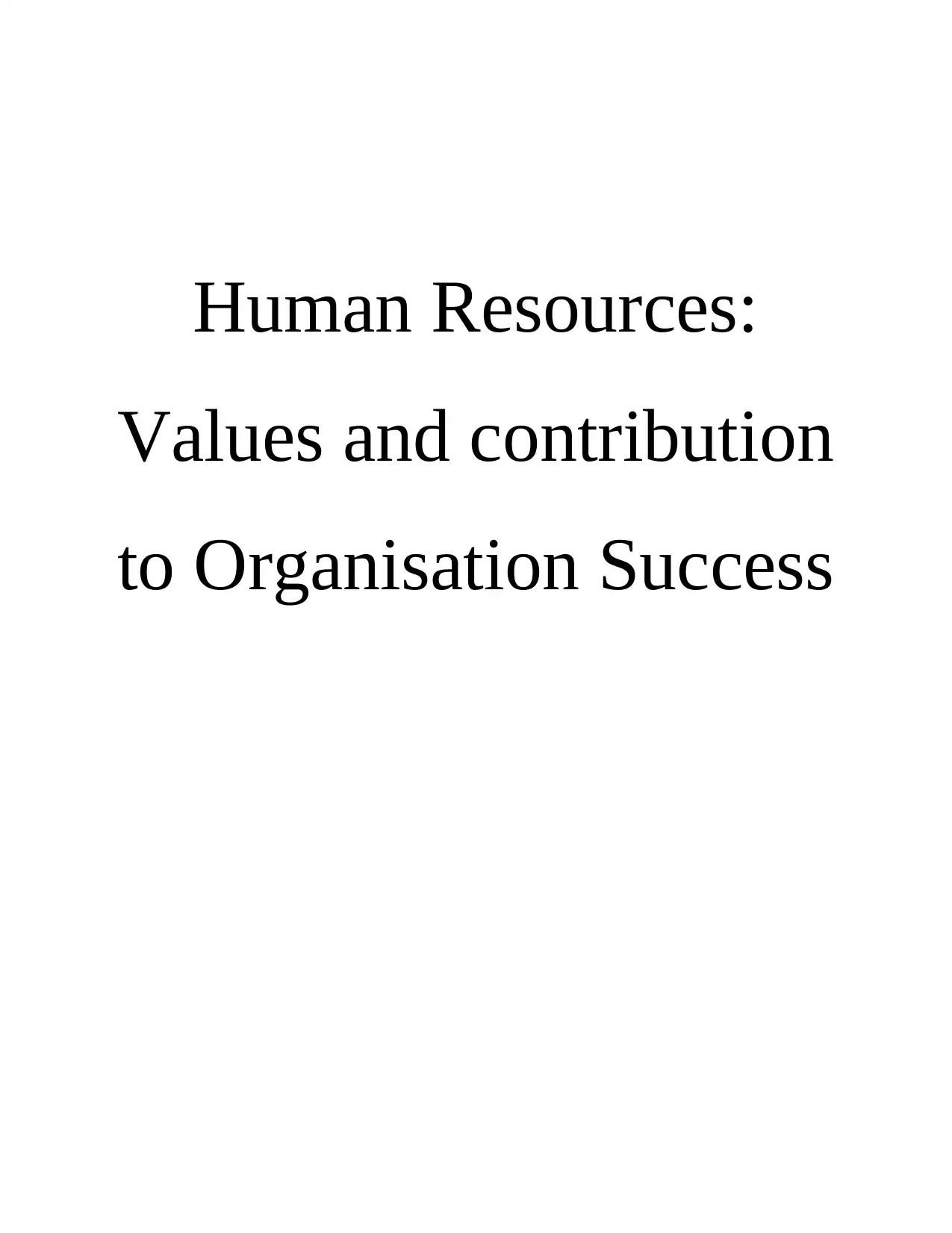
Human Resources:
Values and contribution
to Organisation Success
Values and contribution
to Organisation Success
Paraphrase This Document
Need a fresh take? Get an instant paraphrase of this document with our AI Paraphraser
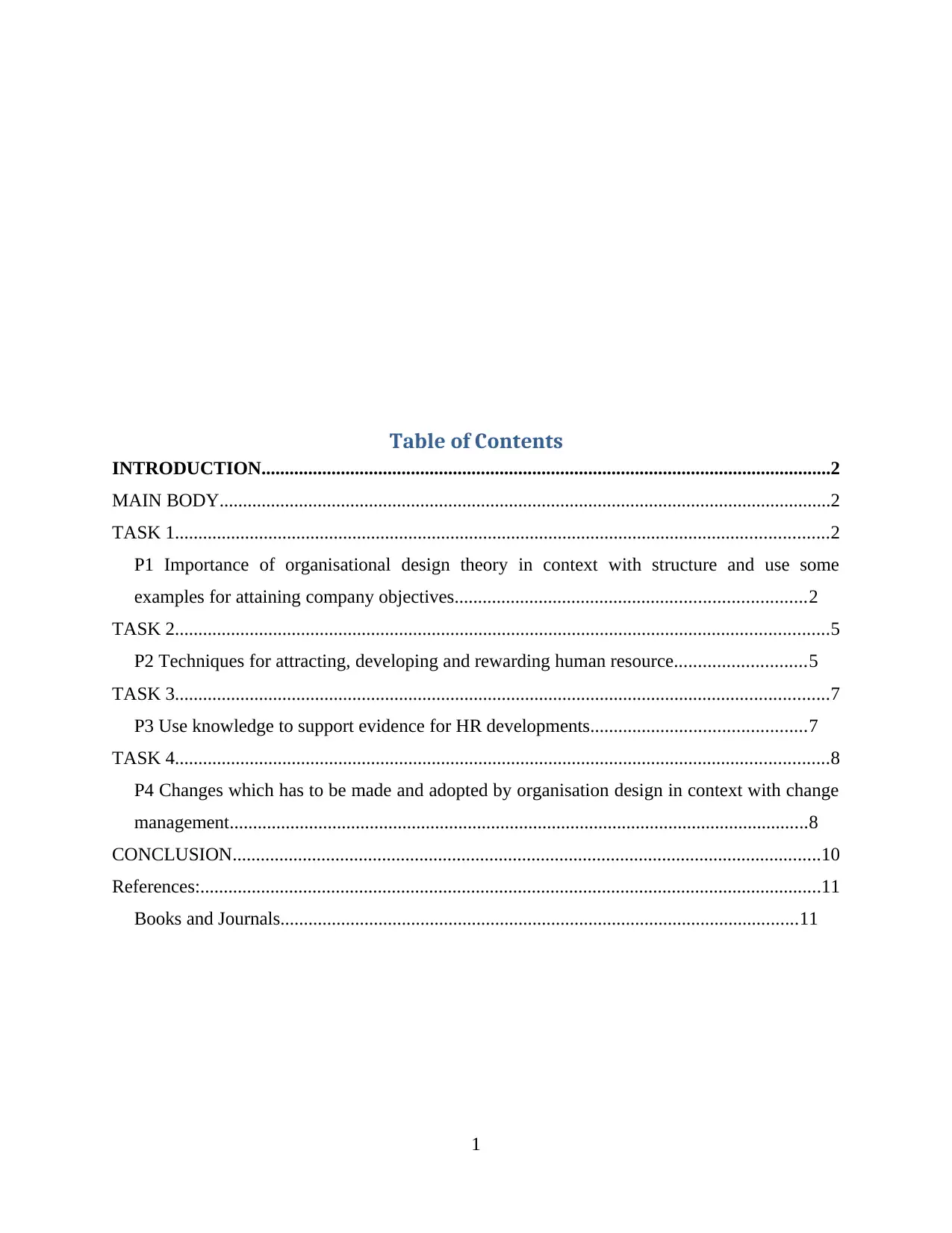
Table of Contents
INTRODUCTION..........................................................................................................................2
MAIN BODY...................................................................................................................................2
TASK 1............................................................................................................................................2
P1 Importance of organisational design theory in context with structure and use some
examples for attaining company objectives...........................................................................2
TASK 2............................................................................................................................................5
P2 Techniques for attracting, developing and rewarding human resource............................5
TASK 3............................................................................................................................................7
P3 Use knowledge to support evidence for HR developments..............................................7
TASK 4............................................................................................................................................8
P4 Changes which has to be made and adopted by organisation design in context with change
management............................................................................................................................8
CONCLUSION..............................................................................................................................10
References:.....................................................................................................................................11
Books and Journals...............................................................................................................11
1
INTRODUCTION..........................................................................................................................2
MAIN BODY...................................................................................................................................2
TASK 1............................................................................................................................................2
P1 Importance of organisational design theory in context with structure and use some
examples for attaining company objectives...........................................................................2
TASK 2............................................................................................................................................5
P2 Techniques for attracting, developing and rewarding human resource............................5
TASK 3............................................................................................................................................7
P3 Use knowledge to support evidence for HR developments..............................................7
TASK 4............................................................................................................................................8
P4 Changes which has to be made and adopted by organisation design in context with change
management............................................................................................................................8
CONCLUSION..............................................................................................................................10
References:.....................................................................................................................................11
Books and Journals...............................................................................................................11
1

INTRODUCTION
The Human resource in any organisation has to manage the employees which are working in the
organisation and their main aim is to help the employees in meeting the goals and objectives.
The department in any organisation is developed to enhance the performance of the employees
and they help in explaining the policies and rules of the organisations to the
employees(Damjanovic-Behrendt and Behrendt, 2019). The main function of the Human
resource department is to employ the people for the vacant positions and provide the required
training in which these employees are weak. Providing training to employees is helpful to them
only as it will help them to learn the work easily and effectively. Sainsbury is the largest
supermarket which is located in London, UK. The company is basically based on providing the
groceries to the people and it was developed by John James Sainsbury. This report will cover
importance of organisation design for sustainable performance, requirements for motivated and
knowledgeable individuals and teams, emerging HR developments and the relationship between
organisational design and change management.
MAIN BODY
TASK 1
P1 Importance of organisational design theory in context with structure and use some examples
for attaining company objectives
Overview of company- Sainsbury is the second largest grocery store in UK which was developed
by John James Sainsbury in the year, 1969. The strategy of the Sainsbury is to build a strong
brand image which includes having the quality products, and 6tries to make the innovation in the
products and the services provided by them(Vizilter, Gorbatcevich and Zheltov, 2019). The
company aims to bring the food at very reasonable prices so that each customer eats the healthy
and the required amount of food. The company is mainly famous for the innovation which they
make and aims to feed 9.7 billion of people by 2050.
Organisational design- Organisational design is the plan or the procedure which is prepared by
the owners or the management team of the company. This helps the company to do the work
according to the procedures and reach to the goals and the objectives. Sainsbury also has plan
which defines the structure, procedures as to how the work has to be done for reaching to the
goals.
2
The Human resource in any organisation has to manage the employees which are working in the
organisation and their main aim is to help the employees in meeting the goals and objectives.
The department in any organisation is developed to enhance the performance of the employees
and they help in explaining the policies and rules of the organisations to the
employees(Damjanovic-Behrendt and Behrendt, 2019). The main function of the Human
resource department is to employ the people for the vacant positions and provide the required
training in which these employees are weak. Providing training to employees is helpful to them
only as it will help them to learn the work easily and effectively. Sainsbury is the largest
supermarket which is located in London, UK. The company is basically based on providing the
groceries to the people and it was developed by John James Sainsbury. This report will cover
importance of organisation design for sustainable performance, requirements for motivated and
knowledgeable individuals and teams, emerging HR developments and the relationship between
organisational design and change management.
MAIN BODY
TASK 1
P1 Importance of organisational design theory in context with structure and use some examples
for attaining company objectives
Overview of company- Sainsbury is the second largest grocery store in UK which was developed
by John James Sainsbury in the year, 1969. The strategy of the Sainsbury is to build a strong
brand image which includes having the quality products, and 6tries to make the innovation in the
products and the services provided by them(Vizilter, Gorbatcevich and Zheltov, 2019). The
company aims to bring the food at very reasonable prices so that each customer eats the healthy
and the required amount of food. The company is mainly famous for the innovation which they
make and aims to feed 9.7 billion of people by 2050.
Organisational design- Organisational design is the plan or the procedure which is prepared by
the owners or the management team of the company. This helps the company to do the work
according to the procedures and reach to the goals and the objectives. Sainsbury also has plan
which defines the structure, procedures as to how the work has to be done for reaching to the
goals.
2
⊘ This is a preview!⊘
Do you want full access?
Subscribe today to unlock all pages.

Trusted by 1+ million students worldwide
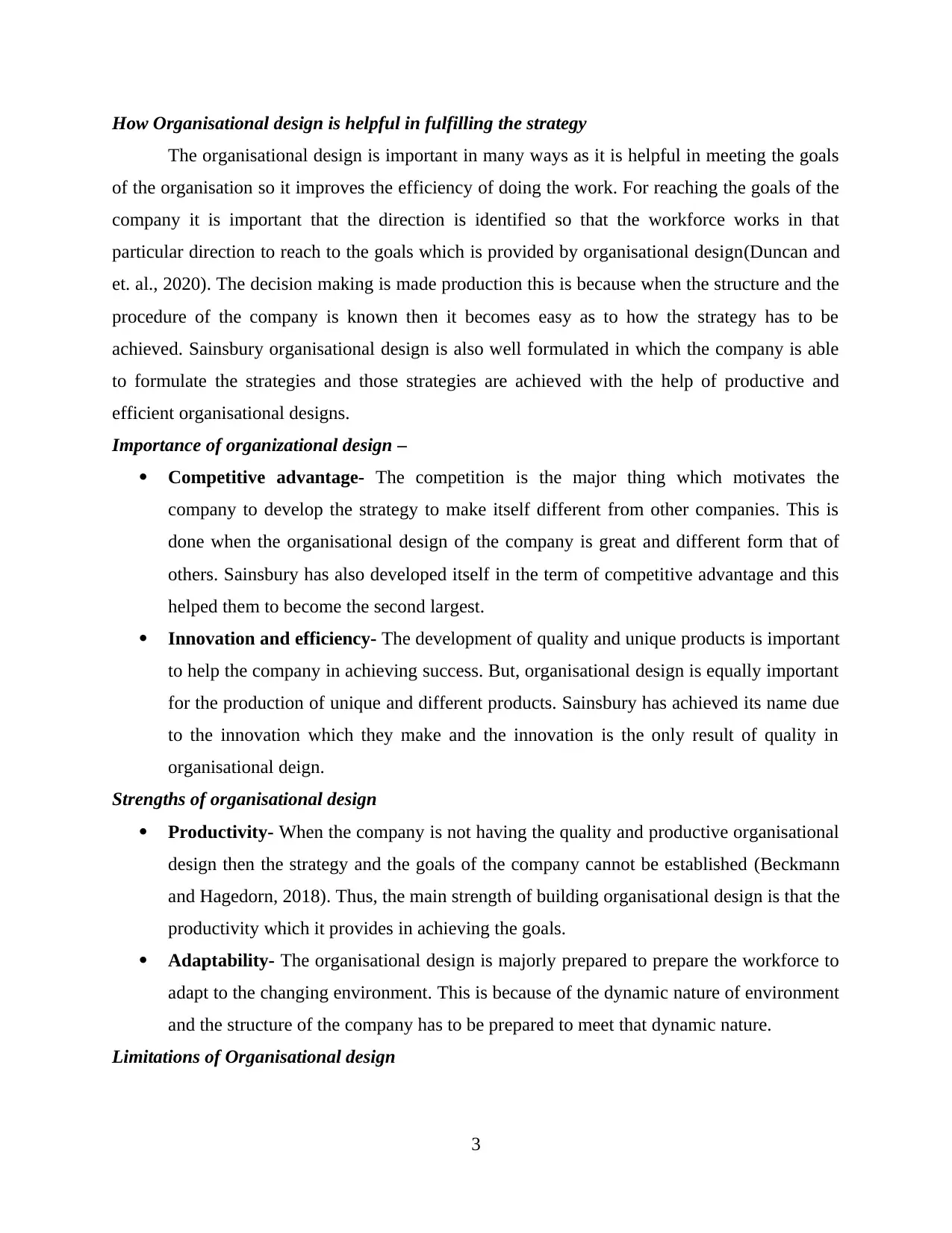
How Organisational design is helpful in fulfilling the strategy
The organisational design is important in many ways as it is helpful in meeting the goals
of the organisation so it improves the efficiency of doing the work. For reaching the goals of the
company it is important that the direction is identified so that the workforce works in that
particular direction to reach to the goals which is provided by organisational design(Duncan and
et. al., 2020). The decision making is made production this is because when the structure and the
procedure of the company is known then it becomes easy as to how the strategy has to be
achieved. Sainsbury organisational design is also well formulated in which the company is able
to formulate the strategies and those strategies are achieved with the help of productive and
efficient organisational designs.
Importance of organizational design –
Competitive advantage- The competition is the major thing which motivates the
company to develop the strategy to make itself different from other companies. This is
done when the organisational design of the company is great and different form that of
others. Sainsbury has also developed itself in the term of competitive advantage and this
helped them to become the second largest.
Innovation and efficiency- The development of quality and unique products is important
to help the company in achieving success. But, organisational design is equally important
for the production of unique and different products. Sainsbury has achieved its name due
to the innovation which they make and the innovation is the only result of quality in
organisational deign.
Strengths of organisational design
Productivity- When the company is not having the quality and productive organisational
design then the strategy and the goals of the company cannot be established (Beckmann
and Hagedorn, 2018). Thus, the main strength of building organisational design is that the
productivity which it provides in achieving the goals.
Adaptability- The organisational design is majorly prepared to prepare the workforce to
adapt to the changing environment. This is because of the dynamic nature of environment
and the structure of the company has to be prepared to meet that dynamic nature.
Limitations of Organisational design
3
The organisational design is important in many ways as it is helpful in meeting the goals
of the organisation so it improves the efficiency of doing the work. For reaching the goals of the
company it is important that the direction is identified so that the workforce works in that
particular direction to reach to the goals which is provided by organisational design(Duncan and
et. al., 2020). The decision making is made production this is because when the structure and the
procedure of the company is known then it becomes easy as to how the strategy has to be
achieved. Sainsbury organisational design is also well formulated in which the company is able
to formulate the strategies and those strategies are achieved with the help of productive and
efficient organisational designs.
Importance of organizational design –
Competitive advantage- The competition is the major thing which motivates the
company to develop the strategy to make itself different from other companies. This is
done when the organisational design of the company is great and different form that of
others. Sainsbury has also developed itself in the term of competitive advantage and this
helped them to become the second largest.
Innovation and efficiency- The development of quality and unique products is important
to help the company in achieving success. But, organisational design is equally important
for the production of unique and different products. Sainsbury has achieved its name due
to the innovation which they make and the innovation is the only result of quality in
organisational deign.
Strengths of organisational design
Productivity- When the company is not having the quality and productive organisational
design then the strategy and the goals of the company cannot be established (Beckmann
and Hagedorn, 2018). Thus, the main strength of building organisational design is that the
productivity which it provides in achieving the goals.
Adaptability- The organisational design is majorly prepared to prepare the workforce to
adapt to the changing environment. This is because of the dynamic nature of environment
and the structure of the company has to be prepared to meet that dynamic nature.
Limitations of Organisational design
3
Paraphrase This Document
Need a fresh take? Get an instant paraphrase of this document with our AI Paraphraser
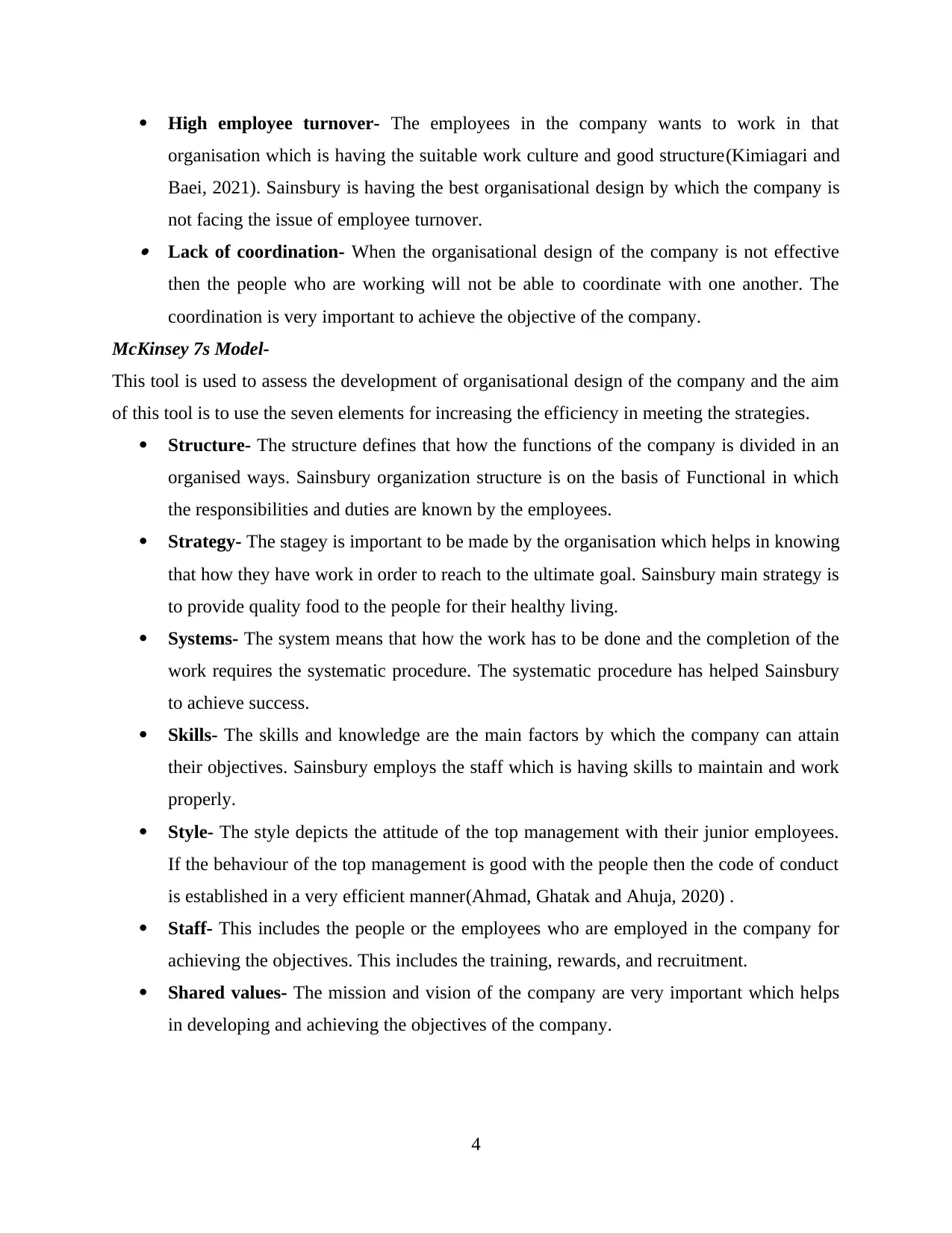
High employee turnover- The employees in the company wants to work in that
organisation which is having the suitable work culture and good structure(Kimiagari and
Baei, 2021). Sainsbury is having the best organisational design by which the company is
not facing the issue of employee turnover. Lack of coordination- When the organisational design of the company is not effective
then the people who are working will not be able to coordinate with one another. The
coordination is very important to achieve the objective of the company.
McKinsey 7s Model-
This tool is used to assess the development of organisational design of the company and the aim
of this tool is to use the seven elements for increasing the efficiency in meeting the strategies.
Structure- The structure defines that how the functions of the company is divided in an
organised ways. Sainsbury organization structure is on the basis of Functional in which
the responsibilities and duties are known by the employees.
Strategy- The stagey is important to be made by the organisation which helps in knowing
that how they have work in order to reach to the ultimate goal. Sainsbury main strategy is
to provide quality food to the people for their healthy living.
Systems- The system means that how the work has to be done and the completion of the
work requires the systematic procedure. The systematic procedure has helped Sainsbury
to achieve success.
Skills- The skills and knowledge are the main factors by which the company can attain
their objectives. Sainsbury employs the staff which is having skills to maintain and work
properly.
Style- The style depicts the attitude of the top management with their junior employees.
If the behaviour of the top management is good with the people then the code of conduct
is established in a very efficient manner(Ahmad, Ghatak and Ahuja, 2020) .
Staff- This includes the people or the employees who are employed in the company for
achieving the objectives. This includes the training, rewards, and recruitment.
Shared values- The mission and vision of the company are very important which helps
in developing and achieving the objectives of the company.
4
organisation which is having the suitable work culture and good structure(Kimiagari and
Baei, 2021). Sainsbury is having the best organisational design by which the company is
not facing the issue of employee turnover. Lack of coordination- When the organisational design of the company is not effective
then the people who are working will not be able to coordinate with one another. The
coordination is very important to achieve the objective of the company.
McKinsey 7s Model-
This tool is used to assess the development of organisational design of the company and the aim
of this tool is to use the seven elements for increasing the efficiency in meeting the strategies.
Structure- The structure defines that how the functions of the company is divided in an
organised ways. Sainsbury organization structure is on the basis of Functional in which
the responsibilities and duties are known by the employees.
Strategy- The stagey is important to be made by the organisation which helps in knowing
that how they have work in order to reach to the ultimate goal. Sainsbury main strategy is
to provide quality food to the people for their healthy living.
Systems- The system means that how the work has to be done and the completion of the
work requires the systematic procedure. The systematic procedure has helped Sainsbury
to achieve success.
Skills- The skills and knowledge are the main factors by which the company can attain
their objectives. Sainsbury employs the staff which is having skills to maintain and work
properly.
Style- The style depicts the attitude of the top management with their junior employees.
If the behaviour of the top management is good with the people then the code of conduct
is established in a very efficient manner(Ahmad, Ghatak and Ahuja, 2020) .
Staff- This includes the people or the employees who are employed in the company for
achieving the objectives. This includes the training, rewards, and recruitment.
Shared values- The mission and vision of the company are very important which helps
in developing and achieving the objectives of the company.
4
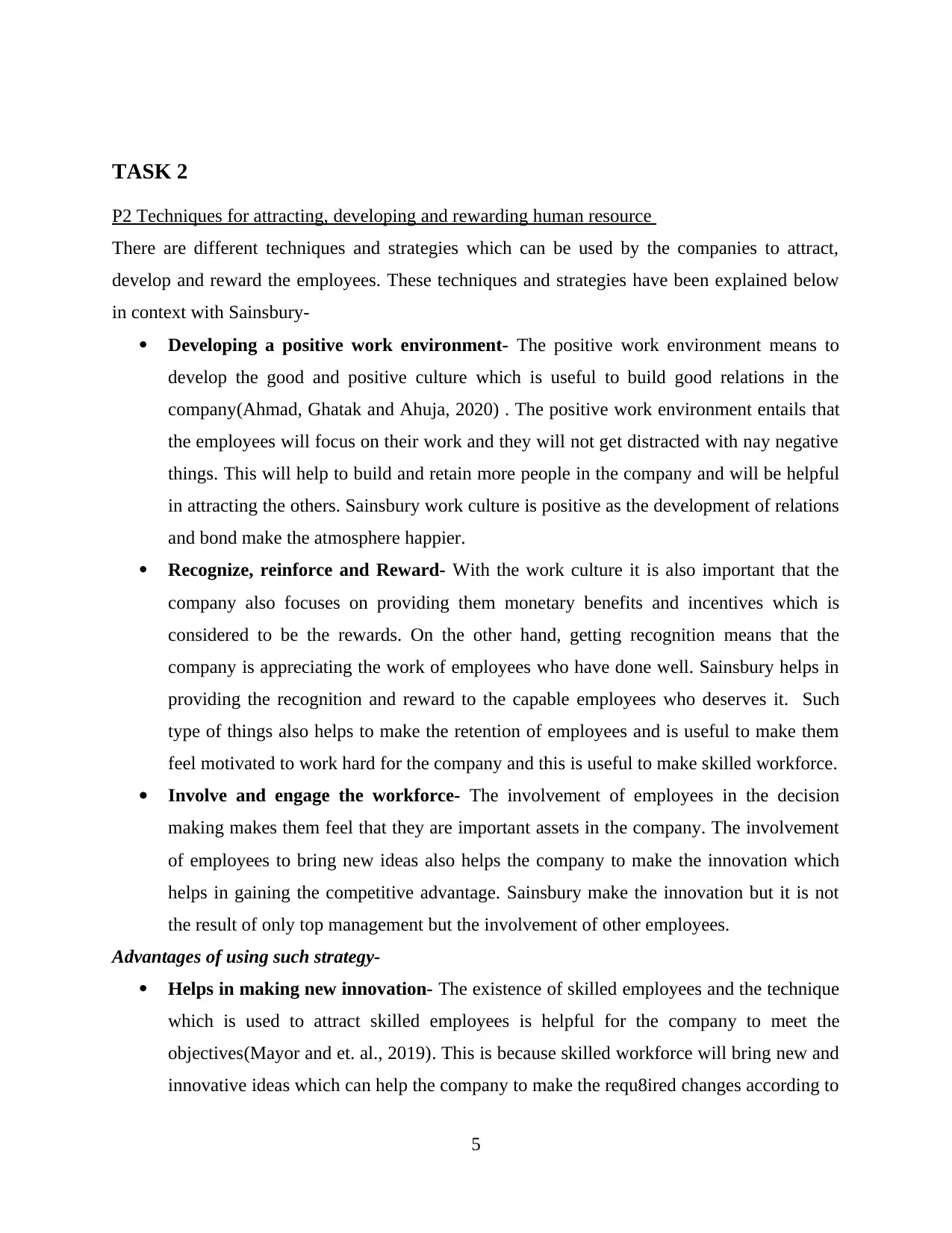
TASK 2
P2 Techniques for attracting, developing and rewarding human resource
There are different techniques and strategies which can be used by the companies to attract,
develop and reward the employees. These techniques and strategies have been explained below
in context with Sainsbury-
Developing a positive work environment- The positive work environment means to
develop the good and positive culture which is useful to build good relations in the
company(Ahmad, Ghatak and Ahuja, 2020) . The positive work environment entails that
the employees will focus on their work and they will not get distracted with nay negative
things. This will help to build and retain more people in the company and will be helpful
in attracting the others. Sainsbury work culture is positive as the development of relations
and bond make the atmosphere happier.
Recognize, reinforce and Reward- With the work culture it is also important that the
company also focuses on providing them monetary benefits and incentives which is
considered to be the rewards. On the other hand, getting recognition means that the
company is appreciating the work of employees who have done well. Sainsbury helps in
providing the recognition and reward to the capable employees who deserves it. Such
type of things also helps to make the retention of employees and is useful to make them
feel motivated to work hard for the company and this is useful to make skilled workforce.
Involve and engage the workforce- The involvement of employees in the decision
making makes them feel that they are important assets in the company. The involvement
of employees to bring new ideas also helps the company to make the innovation which
helps in gaining the competitive advantage. Sainsbury make the innovation but it is not
the result of only top management but the involvement of other employees.
Advantages of using such strategy-
Helps in making new innovation- The existence of skilled employees and the technique
which is used to attract skilled employees is helpful for the company to meet the
objectives(Mayor and et. al., 2019). This is because skilled workforce will bring new and
innovative ideas which can help the company to make the requ8ired changes according to
5
P2 Techniques for attracting, developing and rewarding human resource
There are different techniques and strategies which can be used by the companies to attract,
develop and reward the employees. These techniques and strategies have been explained below
in context with Sainsbury-
Developing a positive work environment- The positive work environment means to
develop the good and positive culture which is useful to build good relations in the
company(Ahmad, Ghatak and Ahuja, 2020) . The positive work environment entails that
the employees will focus on their work and they will not get distracted with nay negative
things. This will help to build and retain more people in the company and will be helpful
in attracting the others. Sainsbury work culture is positive as the development of relations
and bond make the atmosphere happier.
Recognize, reinforce and Reward- With the work culture it is also important that the
company also focuses on providing them monetary benefits and incentives which is
considered to be the rewards. On the other hand, getting recognition means that the
company is appreciating the work of employees who have done well. Sainsbury helps in
providing the recognition and reward to the capable employees who deserves it. Such
type of things also helps to make the retention of employees and is useful to make them
feel motivated to work hard for the company and this is useful to make skilled workforce.
Involve and engage the workforce- The involvement of employees in the decision
making makes them feel that they are important assets in the company. The involvement
of employees to bring new ideas also helps the company to make the innovation which
helps in gaining the competitive advantage. Sainsbury make the innovation but it is not
the result of only top management but the involvement of other employees.
Advantages of using such strategy-
Helps in making new innovation- The existence of skilled employees and the technique
which is used to attract skilled employees is helpful for the company to meet the
objectives(Mayor and et. al., 2019). This is because skilled workforce will bring new and
innovative ideas which can help the company to make the requ8ired changes according to
5
⊘ This is a preview!⊘
Do you want full access?
Subscribe today to unlock all pages.

Trusted by 1+ million students worldwide
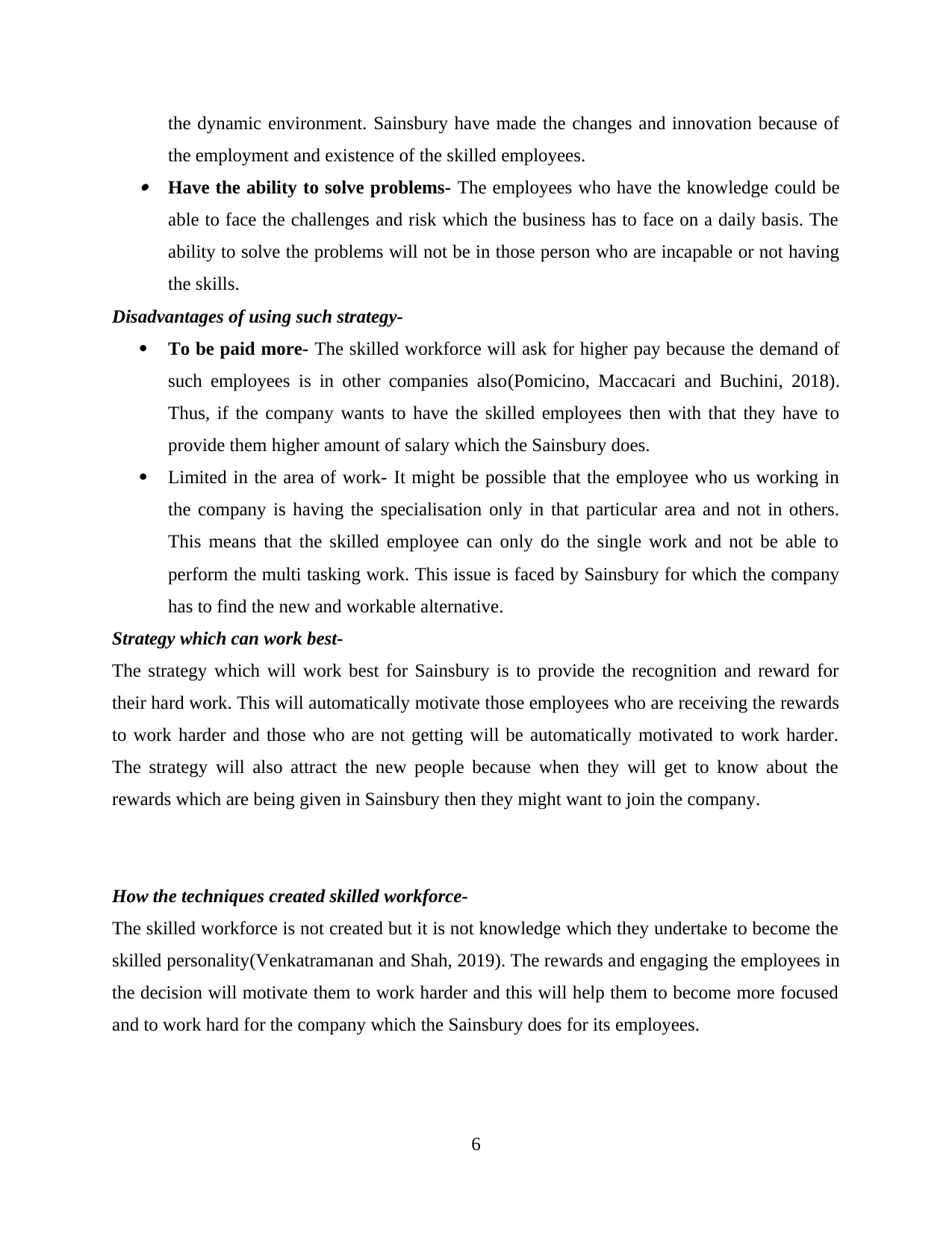
the dynamic environment. Sainsbury have made the changes and innovation because of
the employment and existence of the skilled employees. Have the ability to solve problems- The employees who have the knowledge could be
able to face the challenges and risk which the business has to face on a daily basis. The
ability to solve the problems will not be in those person who are incapable or not having
the skills.
Disadvantages of using such strategy-
To be paid more- The skilled workforce will ask for higher pay because the demand of
such employees is in other companies also(Pomicino, Maccacari and Buchini, 2018).
Thus, if the company wants to have the skilled employees then with that they have to
provide them higher amount of salary which the Sainsbury does.
Limited in the area of work- It might be possible that the employee who us working in
the company is having the specialisation only in that particular area and not in others.
This means that the skilled employee can only do the single work and not be able to
perform the multi tasking work. This issue is faced by Sainsbury for which the company
has to find the new and workable alternative.
Strategy which can work best-
The strategy which will work best for Sainsbury is to provide the recognition and reward for
their hard work. This will automatically motivate those employees who are receiving the rewards
to work harder and those who are not getting will be automatically motivated to work harder.
The strategy will also attract the new people because when they will get to know about the
rewards which are being given in Sainsbury then they might want to join the company.
How the techniques created skilled workforce-
The skilled workforce is not created but it is not knowledge which they undertake to become the
skilled personality(Venkatramanan and Shah, 2019). The rewards and engaging the employees in
the decision will motivate them to work harder and this will help them to become more focused
and to work hard for the company which the Sainsbury does for its employees.
6
the employment and existence of the skilled employees. Have the ability to solve problems- The employees who have the knowledge could be
able to face the challenges and risk which the business has to face on a daily basis. The
ability to solve the problems will not be in those person who are incapable or not having
the skills.
Disadvantages of using such strategy-
To be paid more- The skilled workforce will ask for higher pay because the demand of
such employees is in other companies also(Pomicino, Maccacari and Buchini, 2018).
Thus, if the company wants to have the skilled employees then with that they have to
provide them higher amount of salary which the Sainsbury does.
Limited in the area of work- It might be possible that the employee who us working in
the company is having the specialisation only in that particular area and not in others.
This means that the skilled employee can only do the single work and not be able to
perform the multi tasking work. This issue is faced by Sainsbury for which the company
has to find the new and workable alternative.
Strategy which can work best-
The strategy which will work best for Sainsbury is to provide the recognition and reward for
their hard work. This will automatically motivate those employees who are receiving the rewards
to work harder and those who are not getting will be automatically motivated to work harder.
The strategy will also attract the new people because when they will get to know about the
rewards which are being given in Sainsbury then they might want to join the company.
How the techniques created skilled workforce-
The skilled workforce is not created but it is not knowledge which they undertake to become the
skilled personality(Venkatramanan and Shah, 2019). The rewards and engaging the employees in
the decision will motivate them to work harder and this will help them to become more focused
and to work hard for the company which the Sainsbury does for its employees.
6
Paraphrase This Document
Need a fresh take? Get an instant paraphrase of this document with our AI Paraphraser
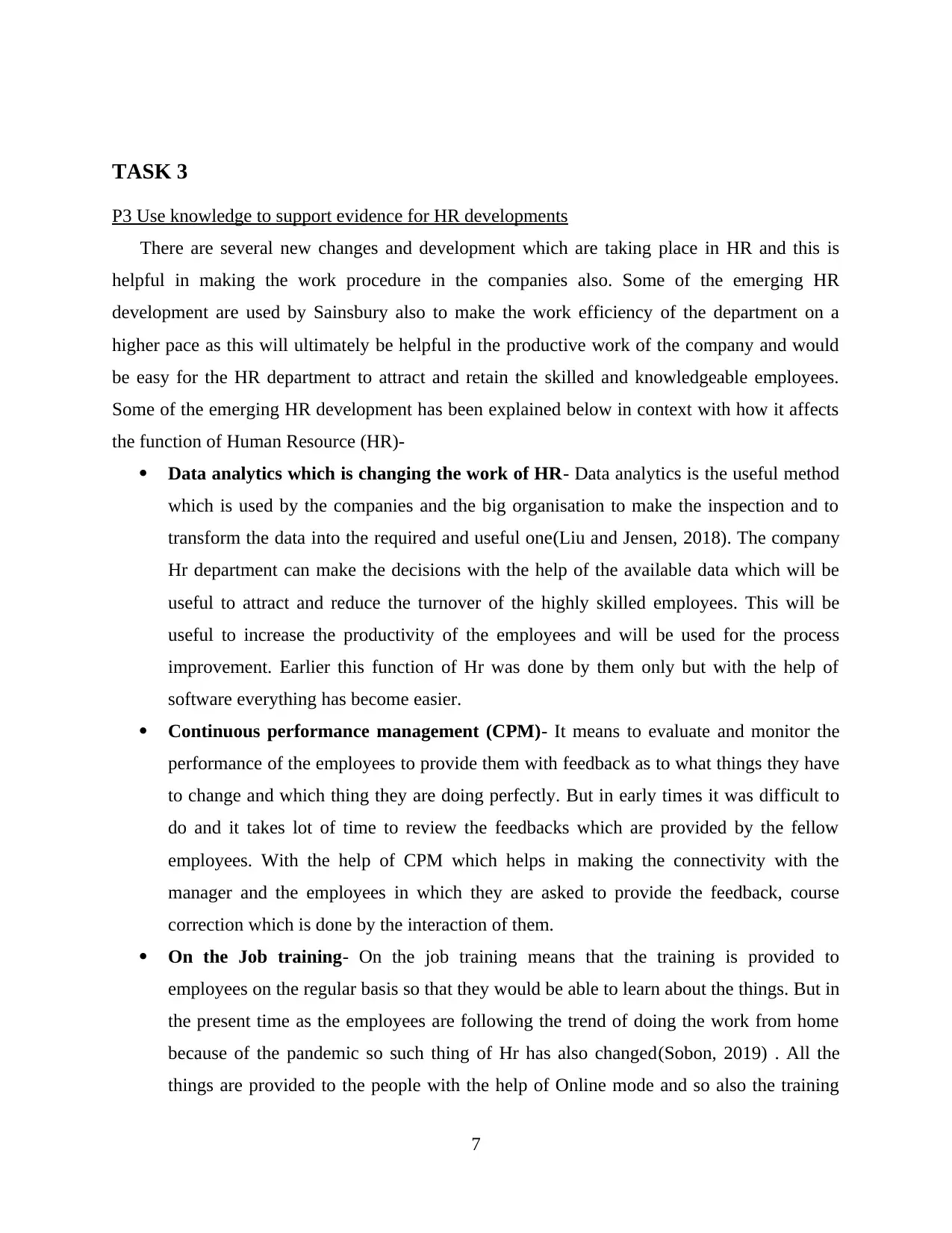
TASK 3
P3 Use knowledge to support evidence for HR developments
There are several new changes and development which are taking place in HR and this is
helpful in making the work procedure in the companies also. Some of the emerging HR
development are used by Sainsbury also to make the work efficiency of the department on a
higher pace as this will ultimately be helpful in the productive work of the company and would
be easy for the HR department to attract and retain the skilled and knowledgeable employees.
Some of the emerging HR development has been explained below in context with how it affects
the function of Human Resource (HR)-
Data analytics which is changing the work of HR- Data analytics is the useful method
which is used by the companies and the big organisation to make the inspection and to
transform the data into the required and useful one(Liu and Jensen, 2018). The company
Hr department can make the decisions with the help of the available data which will be
useful to attract and reduce the turnover of the highly skilled employees. This will be
useful to increase the productivity of the employees and will be used for the process
improvement. Earlier this function of Hr was done by them only but with the help of
software everything has become easier.
Continuous performance management (CPM)- It means to evaluate and monitor the
performance of the employees to provide them with feedback as to what things they have
to change and which thing they are doing perfectly. But in early times it was difficult to
do and it takes lot of time to review the feedbacks which are provided by the fellow
employees. With the help of CPM which helps in making the connectivity with the
manager and the employees in which they are asked to provide the feedback, course
correction which is done by the interaction of them.
On the Job training- On the job training means that the training is provided to
employees on the regular basis so that they would be able to learn about the things. But in
the present time as the employees are following the trend of doing the work from home
because of the pandemic so such thing of Hr has also changed(Sobon, 2019) . All the
things are provided to the people with the help of Online mode and so also the training
7
P3 Use knowledge to support evidence for HR developments
There are several new changes and development which are taking place in HR and this is
helpful in making the work procedure in the companies also. Some of the emerging HR
development are used by Sainsbury also to make the work efficiency of the department on a
higher pace as this will ultimately be helpful in the productive work of the company and would
be easy for the HR department to attract and retain the skilled and knowledgeable employees.
Some of the emerging HR development has been explained below in context with how it affects
the function of Human Resource (HR)-
Data analytics which is changing the work of HR- Data analytics is the useful method
which is used by the companies and the big organisation to make the inspection and to
transform the data into the required and useful one(Liu and Jensen, 2018). The company
Hr department can make the decisions with the help of the available data which will be
useful to attract and reduce the turnover of the highly skilled employees. This will be
useful to increase the productivity of the employees and will be used for the process
improvement. Earlier this function of Hr was done by them only but with the help of
software everything has become easier.
Continuous performance management (CPM)- It means to evaluate and monitor the
performance of the employees to provide them with feedback as to what things they have
to change and which thing they are doing perfectly. But in early times it was difficult to
do and it takes lot of time to review the feedbacks which are provided by the fellow
employees. With the help of CPM which helps in making the connectivity with the
manager and the employees in which they are asked to provide the feedback, course
correction which is done by the interaction of them.
On the Job training- On the job training means that the training is provided to
employees on the regular basis so that they would be able to learn about the things. But in
the present time as the employees are following the trend of doing the work from home
because of the pandemic so such thing of Hr has also changed(Sobon, 2019) . All the
things are provided to the people with the help of Online mode and so also the training
7
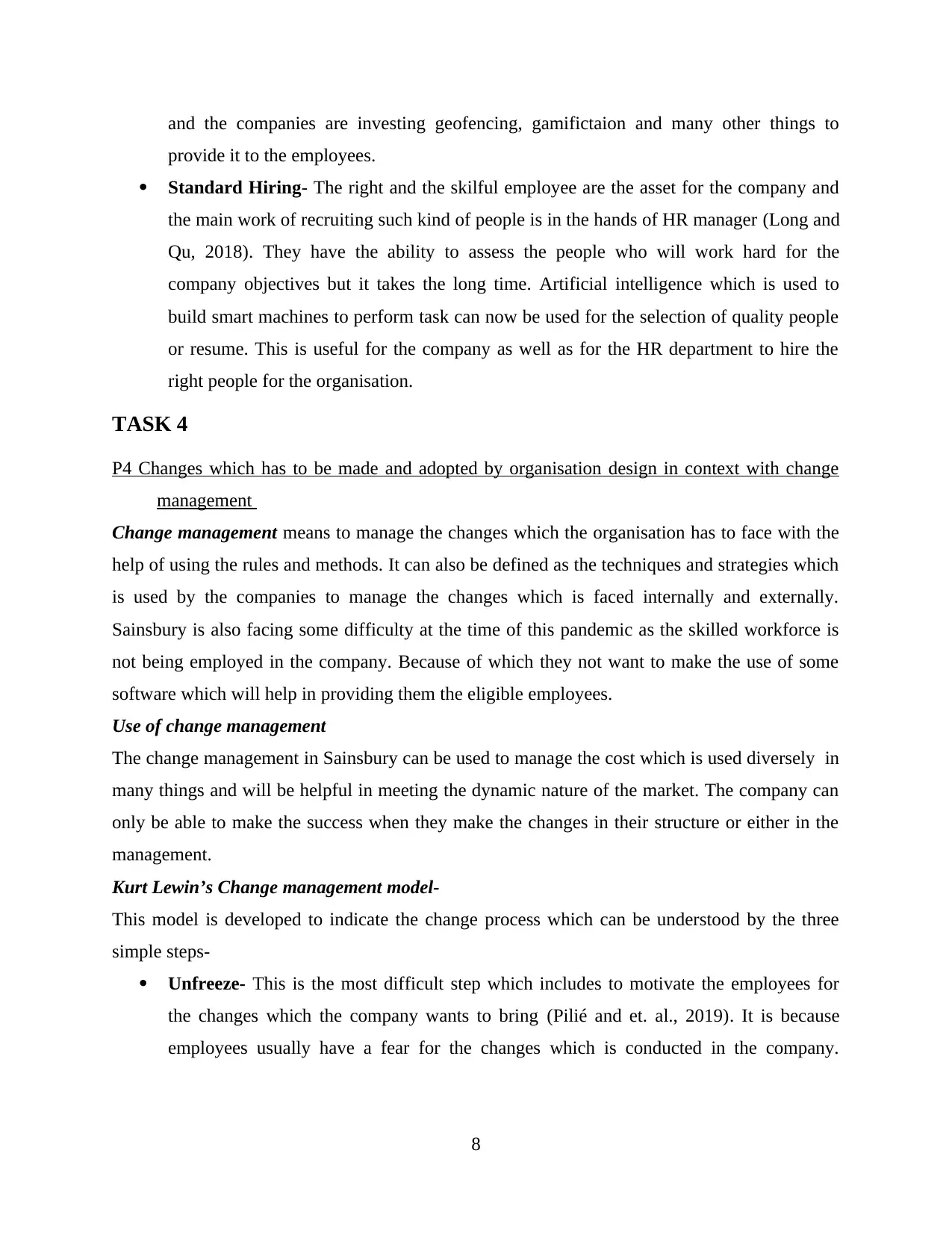
and the companies are investing geofencing, gamifictaion and many other things to
provide it to the employees.
Standard Hiring- The right and the skilful employee are the asset for the company and
the main work of recruiting such kind of people is in the hands of HR manager (Long and
Qu, 2018). They have the ability to assess the people who will work hard for the
company objectives but it takes the long time. Artificial intelligence which is used to
build smart machines to perform task can now be used for the selection of quality people
or resume. This is useful for the company as well as for the HR department to hire the
right people for the organisation.
TASK 4
P4 Changes which has to be made and adopted by organisation design in context with change
management
Change management means to manage the changes which the organisation has to face with the
help of using the rules and methods. It can also be defined as the techniques and strategies which
is used by the companies to manage the changes which is faced internally and externally.
Sainsbury is also facing some difficulty at the time of this pandemic as the skilled workforce is
not being employed in the company. Because of which they not want to make the use of some
software which will help in providing them the eligible employees.
Use of change management
The change management in Sainsbury can be used to manage the cost which is used diversely in
many things and will be helpful in meeting the dynamic nature of the market. The company can
only be able to make the success when they make the changes in their structure or either in the
management.
Kurt Lewin’s Change management model-
This model is developed to indicate the change process which can be understood by the three
simple steps-
Unfreeze- This is the most difficult step which includes to motivate the employees for
the changes which the company wants to bring (Pilié and et. al., 2019). It is because
employees usually have a fear for the changes which is conducted in the company.
8
provide it to the employees.
Standard Hiring- The right and the skilful employee are the asset for the company and
the main work of recruiting such kind of people is in the hands of HR manager (Long and
Qu, 2018). They have the ability to assess the people who will work hard for the
company objectives but it takes the long time. Artificial intelligence which is used to
build smart machines to perform task can now be used for the selection of quality people
or resume. This is useful for the company as well as for the HR department to hire the
right people for the organisation.
TASK 4
P4 Changes which has to be made and adopted by organisation design in context with change
management
Change management means to manage the changes which the organisation has to face with the
help of using the rules and methods. It can also be defined as the techniques and strategies which
is used by the companies to manage the changes which is faced internally and externally.
Sainsbury is also facing some difficulty at the time of this pandemic as the skilled workforce is
not being employed in the company. Because of which they not want to make the use of some
software which will help in providing them the eligible employees.
Use of change management
The change management in Sainsbury can be used to manage the cost which is used diversely in
many things and will be helpful in meeting the dynamic nature of the market. The company can
only be able to make the success when they make the changes in their structure or either in the
management.
Kurt Lewin’s Change management model-
This model is developed to indicate the change process which can be understood by the three
simple steps-
Unfreeze- This is the most difficult step which includes to motivate the employees for
the changes which the company wants to bring (Pilié and et. al., 2019). It is because
employees usually have a fear for the changes which is conducted in the company.
8
⊘ This is a preview!⊘
Do you want full access?
Subscribe today to unlock all pages.

Trusted by 1+ million students worldwide
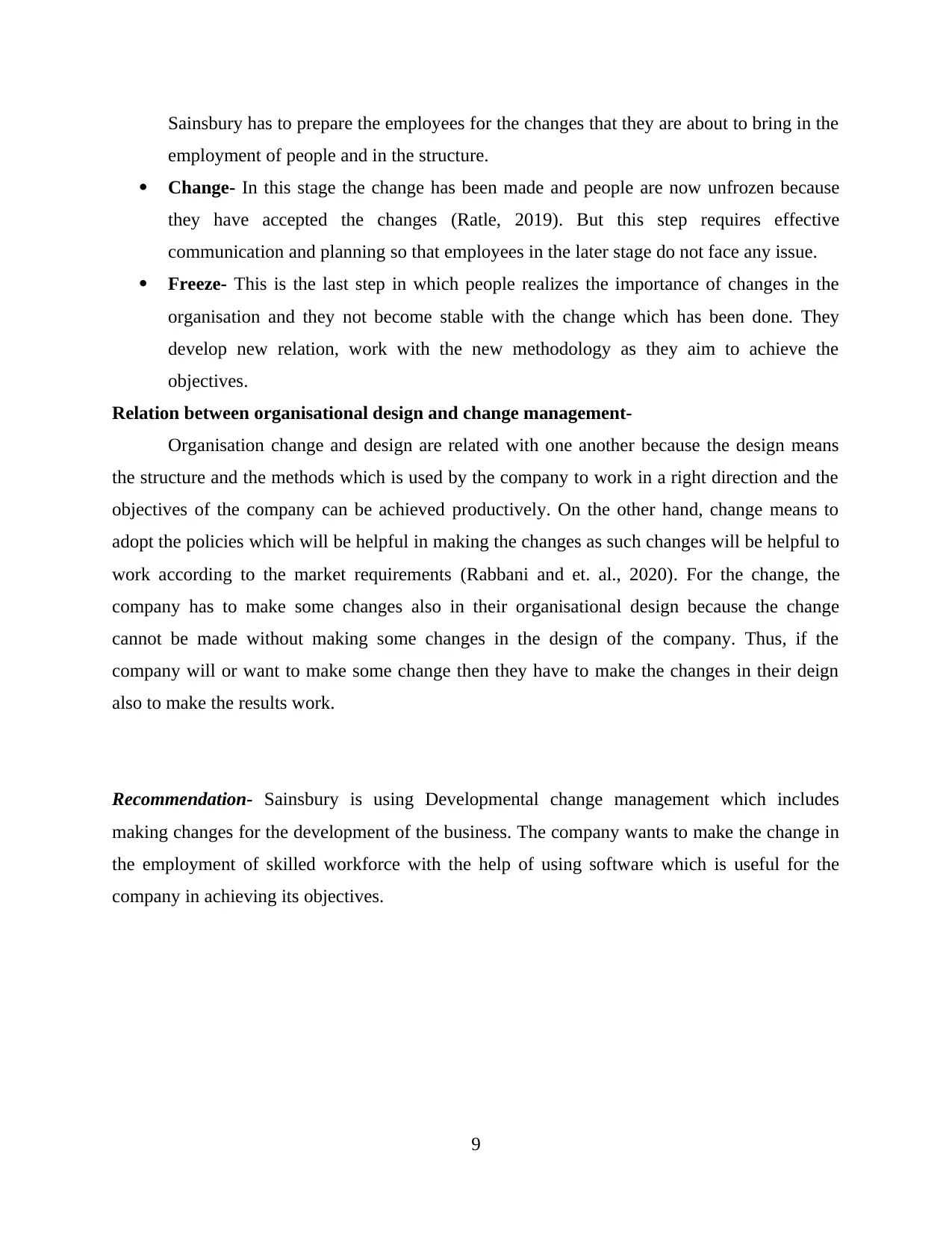
Sainsbury has to prepare the employees for the changes that they are about to bring in the
employment of people and in the structure.
Change- In this stage the change has been made and people are now unfrozen because
they have accepted the changes (Ratle, 2019). But this step requires effective
communication and planning so that employees in the later stage do not face any issue.
Freeze- This is the last step in which people realizes the importance of changes in the
organisation and they not become stable with the change which has been done. They
develop new relation, work with the new methodology as they aim to achieve the
objectives.
Relation between organisational design and change management-
Organisation change and design are related with one another because the design means
the structure and the methods which is used by the company to work in a right direction and the
objectives of the company can be achieved productively. On the other hand, change means to
adopt the policies which will be helpful in making the changes as such changes will be helpful to
work according to the market requirements (Rabbani and et. al., 2020). For the change, the
company has to make some changes also in their organisational design because the change
cannot be made without making some changes in the design of the company. Thus, if the
company will or want to make some change then they have to make the changes in their deign
also to make the results work.
Recommendation- Sainsbury is using Developmental change management which includes
making changes for the development of the business. The company wants to make the change in
the employment of skilled workforce with the help of using software which is useful for the
company in achieving its objectives.
9
employment of people and in the structure.
Change- In this stage the change has been made and people are now unfrozen because
they have accepted the changes (Ratle, 2019). But this step requires effective
communication and planning so that employees in the later stage do not face any issue.
Freeze- This is the last step in which people realizes the importance of changes in the
organisation and they not become stable with the change which has been done. They
develop new relation, work with the new methodology as they aim to achieve the
objectives.
Relation between organisational design and change management-
Organisation change and design are related with one another because the design means
the structure and the methods which is used by the company to work in a right direction and the
objectives of the company can be achieved productively. On the other hand, change means to
adopt the policies which will be helpful in making the changes as such changes will be helpful to
work according to the market requirements (Rabbani and et. al., 2020). For the change, the
company has to make some changes also in their organisational design because the change
cannot be made without making some changes in the design of the company. Thus, if the
company will or want to make some change then they have to make the changes in their deign
also to make the results work.
Recommendation- Sainsbury is using Developmental change management which includes
making changes for the development of the business. The company wants to make the change in
the employment of skilled workforce with the help of using software which is useful for the
company in achieving its objectives.
9
Paraphrase This Document
Need a fresh take? Get an instant paraphrase of this document with our AI Paraphraser
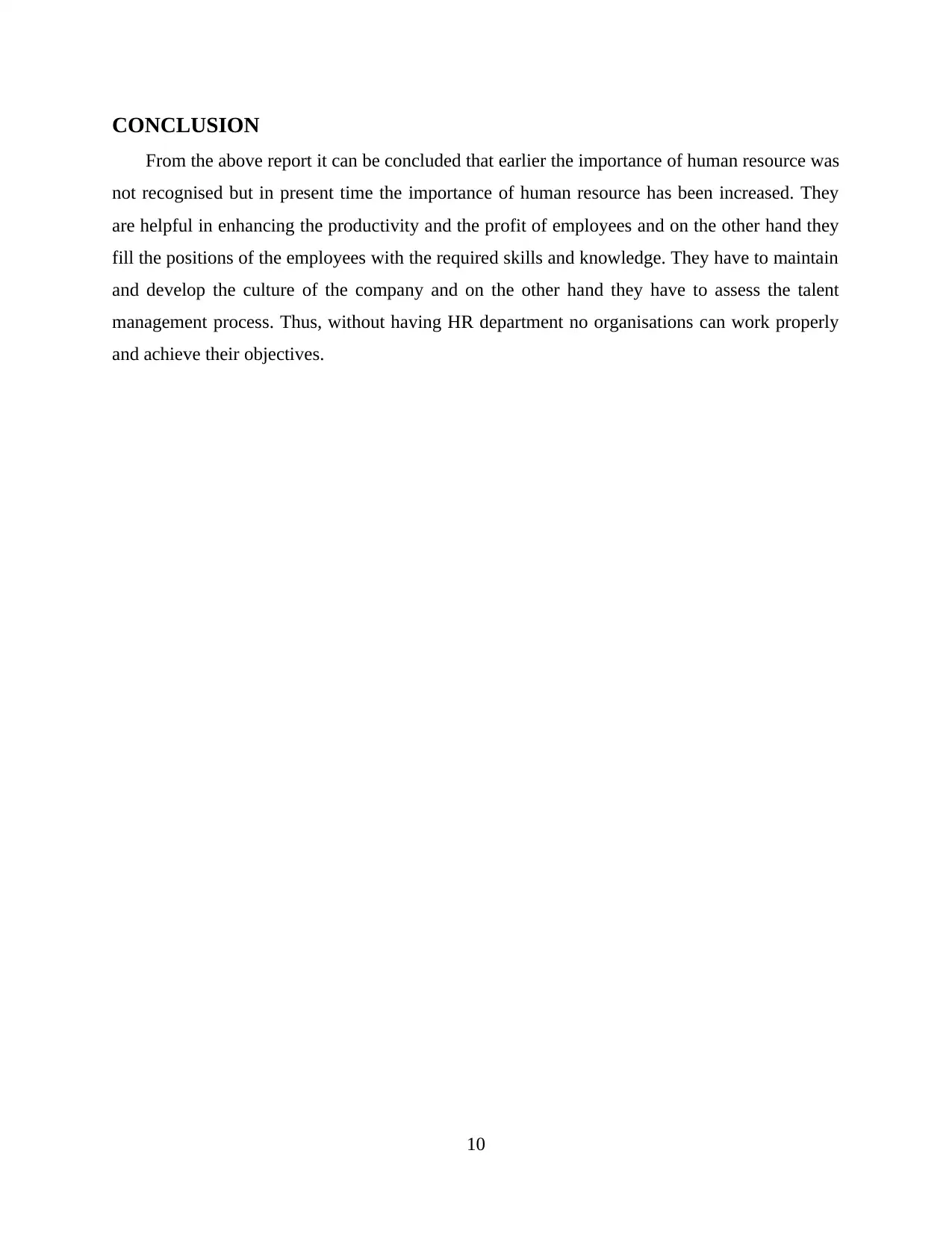
CONCLUSION
From the above report it can be concluded that earlier the importance of human resource was
not recognised but in present time the importance of human resource has been increased. They
are helpful in enhancing the productivity and the profit of employees and on the other hand they
fill the positions of the employees with the required skills and knowledge. They have to maintain
and develop the culture of the company and on the other hand they have to assess the talent
management process. Thus, without having HR department no organisations can work properly
and achieve their objectives.
10
From the above report it can be concluded that earlier the importance of human resource was
not recognised but in present time the importance of human resource has been increased. They
are helpful in enhancing the productivity and the profit of employees and on the other hand they
fill the positions of the employees with the required skills and knowledge. They have to maintain
and develop the culture of the company and on the other hand they have to assess the talent
management process. Thus, without having HR department no organisations can work properly
and achieve their objectives.
10
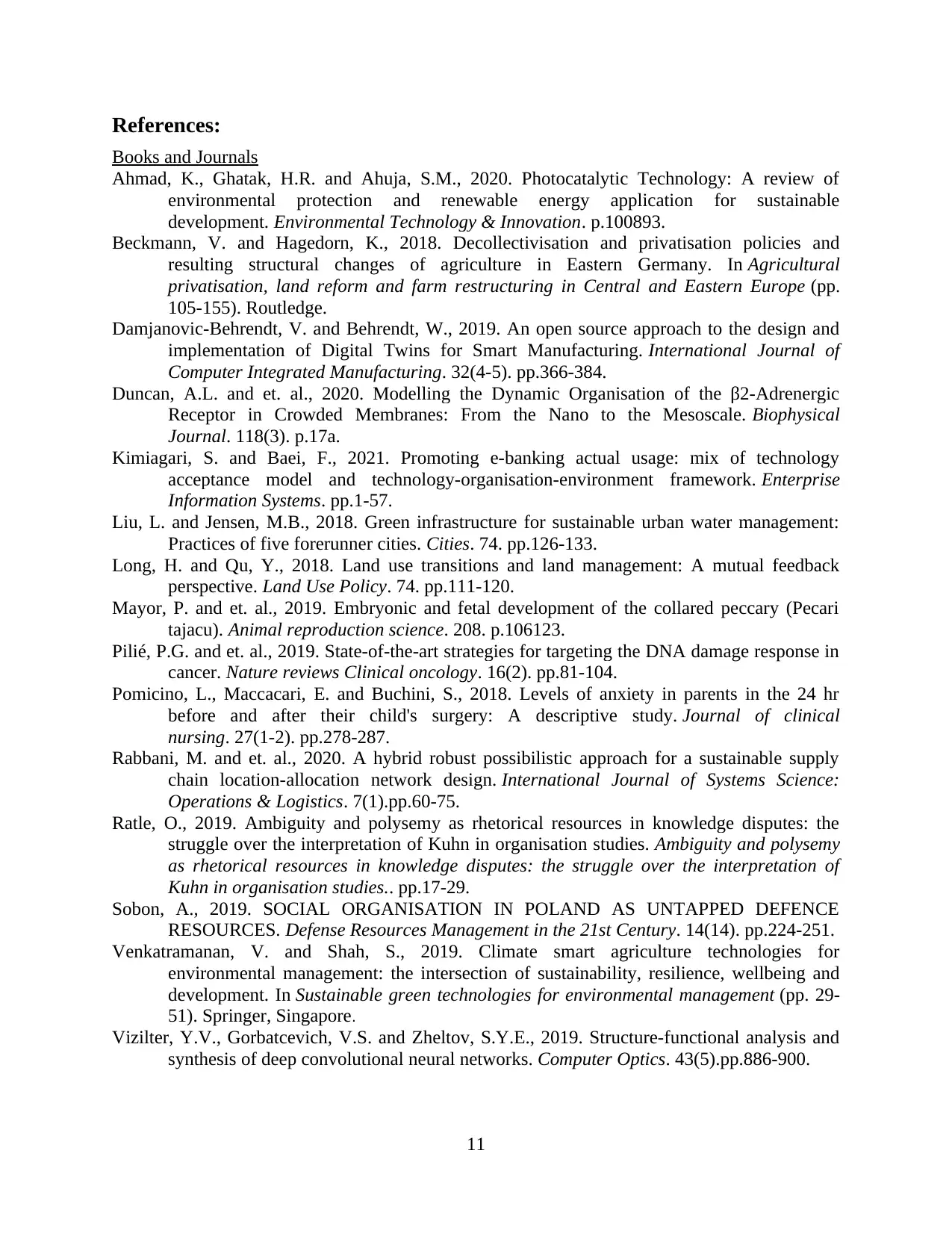
References:
Books and Journals
Ahmad, K., Ghatak, H.R. and Ahuja, S.M., 2020. Photocatalytic Technology: A review of
environmental protection and renewable energy application for sustainable
development. Environmental Technology & Innovation. p.100893.
Beckmann, V. and Hagedorn, K., 2018. Decollectivisation and privatisation policies and
resulting structural changes of agriculture in Eastern Germany. In Agricultural
privatisation, land reform and farm restructuring in Central and Eastern Europe (pp.
105-155). Routledge.
Damjanovic-Behrendt, V. and Behrendt, W., 2019. An open source approach to the design and
implementation of Digital Twins for Smart Manufacturing. International Journal of
Computer Integrated Manufacturing. 32(4-5). pp.366-384.
Duncan, A.L. and et. al., 2020. Modelling the Dynamic Organisation of the β2-Adrenergic
Receptor in Crowded Membranes: From the Nano to the Mesoscale. Biophysical
Journal. 118(3). p.17a.
Kimiagari, S. and Baei, F., 2021. Promoting e-banking actual usage: mix of technology
acceptance model and technology-organisation-environment framework. Enterprise
Information Systems. pp.1-57.
Liu, L. and Jensen, M.B., 2018. Green infrastructure for sustainable urban water management:
Practices of five forerunner cities. Cities. 74. pp.126-133.
Long, H. and Qu, Y., 2018. Land use transitions and land management: A mutual feedback
perspective. Land Use Policy. 74. pp.111-120.
Mayor, P. and et. al., 2019. Embryonic and fetal development of the collared peccary (Pecari
tajacu). Animal reproduction science. 208. p.106123.
Pilié, P.G. and et. al., 2019. State-of-the-art strategies for targeting the DNA damage response in
cancer. Nature reviews Clinical oncology. 16(2). pp.81-104.
Pomicino, L., Maccacari, E. and Buchini, S., 2018. Levels of anxiety in parents in the 24 hr
before and after their child's surgery: A descriptive study. Journal of clinical
nursing. 27(1-2). pp.278-287.
Rabbani, M. and et. al., 2020. A hybrid robust possibilistic approach for a sustainable supply
chain location-allocation network design. International Journal of Systems Science:
Operations & Logistics. 7(1).pp.60-75.
Ratle, O., 2019. Ambiguity and polysemy as rhetorical resources in knowledge disputes: the
struggle over the interpretation of Kuhn in organisation studies. Ambiguity and polysemy
as rhetorical resources in knowledge disputes: the struggle over the interpretation of
Kuhn in organisation studies.. pp.17-29.
Sobon, A., 2019. SOCIAL ORGANISATION IN POLAND AS UNTAPPED DEFENCE
RESOURCES. Defense Resources Management in the 21st Century. 14(14). pp.224-251.
Venkatramanan, V. and Shah, S., 2019. Climate smart agriculture technologies for
environmental management: the intersection of sustainability, resilience, wellbeing and
development. In Sustainable green technologies for environmental management (pp. 29-
51). Springer, Singapore.
Vizilter, Y.V., Gorbatcevich, V.S. and Zheltov, S.Y.E., 2019. Structure-functional analysis and
synthesis of deep convolutional neural networks. Computer Optics. 43(5).pp.886-900.
11
Books and Journals
Ahmad, K., Ghatak, H.R. and Ahuja, S.M., 2020. Photocatalytic Technology: A review of
environmental protection and renewable energy application for sustainable
development. Environmental Technology & Innovation. p.100893.
Beckmann, V. and Hagedorn, K., 2018. Decollectivisation and privatisation policies and
resulting structural changes of agriculture in Eastern Germany. In Agricultural
privatisation, land reform and farm restructuring in Central and Eastern Europe (pp.
105-155). Routledge.
Damjanovic-Behrendt, V. and Behrendt, W., 2019. An open source approach to the design and
implementation of Digital Twins for Smart Manufacturing. International Journal of
Computer Integrated Manufacturing. 32(4-5). pp.366-384.
Duncan, A.L. and et. al., 2020. Modelling the Dynamic Organisation of the β2-Adrenergic
Receptor in Crowded Membranes: From the Nano to the Mesoscale. Biophysical
Journal. 118(3). p.17a.
Kimiagari, S. and Baei, F., 2021. Promoting e-banking actual usage: mix of technology
acceptance model and technology-organisation-environment framework. Enterprise
Information Systems. pp.1-57.
Liu, L. and Jensen, M.B., 2018. Green infrastructure for sustainable urban water management:
Practices of five forerunner cities. Cities. 74. pp.126-133.
Long, H. and Qu, Y., 2018. Land use transitions and land management: A mutual feedback
perspective. Land Use Policy. 74. pp.111-120.
Mayor, P. and et. al., 2019. Embryonic and fetal development of the collared peccary (Pecari
tajacu). Animal reproduction science. 208. p.106123.
Pilié, P.G. and et. al., 2019. State-of-the-art strategies for targeting the DNA damage response in
cancer. Nature reviews Clinical oncology. 16(2). pp.81-104.
Pomicino, L., Maccacari, E. and Buchini, S., 2018. Levels of anxiety in parents in the 24 hr
before and after their child's surgery: A descriptive study. Journal of clinical
nursing. 27(1-2). pp.278-287.
Rabbani, M. and et. al., 2020. A hybrid robust possibilistic approach for a sustainable supply
chain location-allocation network design. International Journal of Systems Science:
Operations & Logistics. 7(1).pp.60-75.
Ratle, O., 2019. Ambiguity and polysemy as rhetorical resources in knowledge disputes: the
struggle over the interpretation of Kuhn in organisation studies. Ambiguity and polysemy
as rhetorical resources in knowledge disputes: the struggle over the interpretation of
Kuhn in organisation studies.. pp.17-29.
Sobon, A., 2019. SOCIAL ORGANISATION IN POLAND AS UNTAPPED DEFENCE
RESOURCES. Defense Resources Management in the 21st Century. 14(14). pp.224-251.
Venkatramanan, V. and Shah, S., 2019. Climate smart agriculture technologies for
environmental management: the intersection of sustainability, resilience, wellbeing and
development. In Sustainable green technologies for environmental management (pp. 29-
51). Springer, Singapore.
Vizilter, Y.V., Gorbatcevich, V.S. and Zheltov, S.Y.E., 2019. Structure-functional analysis and
synthesis of deep convolutional neural networks. Computer Optics. 43(5).pp.886-900.
11
⊘ This is a preview!⊘
Do you want full access?
Subscribe today to unlock all pages.

Trusted by 1+ million students worldwide
1 out of 13
Related Documents
Your All-in-One AI-Powered Toolkit for Academic Success.
+13062052269
info@desklib.com
Available 24*7 on WhatsApp / Email
![[object Object]](/_next/static/media/star-bottom.7253800d.svg)
Unlock your academic potential
Copyright © 2020–2025 A2Z Services. All Rights Reserved. Developed and managed by ZUCOL.





